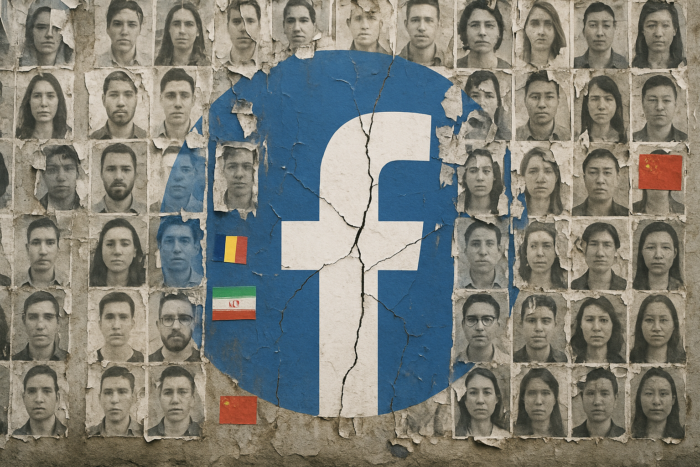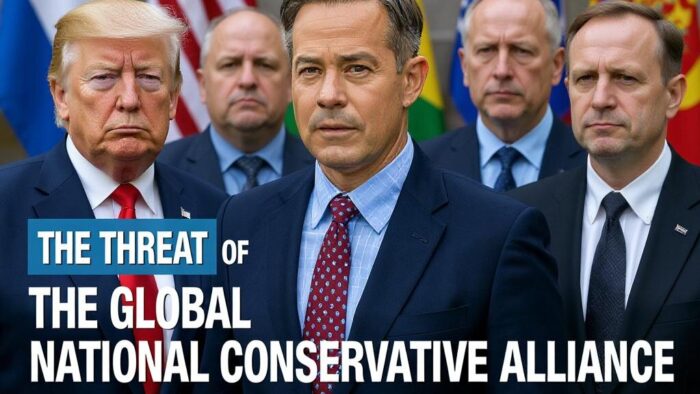The Global Influence Operations Report (GIOR) is pleased to present Part 3 of our series on the threat posed by the Global National Conservative Alliance (GNCA):
“We are not provinces of an empire,” Marine Le Pen declared to 6,000 supporters at the Patriots Europe rally in Mormant-sur-Vernisson, France, in June 2025. Viktor Orbán proclaimed that Hungary had become “the nightmare of the European Union” and “the last bastion of Christian Europe.”
The gathering summoned a ghost of pre-Hitler Weimar Germany: the Harzburg Front rally of October 1931, where Alfred Hugenberg and his DNVP conservatives formed what they called the “National Opposition” with Hitler’s Nazis. Hugenberg planned to use the rally “as a platform to organize a shadow cabinet under his leadership that would unite the Right,” convinced he could control the Nazi movement for his own political ends. Within sixteen months, Hitler ruled alone. (The German National People’s Party (German: Deutschnationale Volkspartei, DNVP) was a national conservative and monarchist political party in Germany during the Weimar Republic.)
That bargain—respectability riding radicalism-now powers a 21st-century coalition.
The Global National Conservative Alliance
The Global National Conservative Alliance (GNCA) is an ideological coalition spanning continents—Orbán’s Fidesz in Hungary, Le Pen’s National Rally in France, Germany’s AfD, Spain’s Vox, Poland’s Law and Justice party, and the MAGA wing of the US Republican Party. Think of it as a constellation of parties, think tanks and influencers linked by three core instincts: nation over supranational rules, cultural homogeneity over pluralism, and deep suspicion of global institutions.
Foreign autocracies amplify this network through what intelligence analysts call an engineered feedback loop: messages originate in Moscow or Beijing, get packaged through encrypted channels, then re-enter Western debate as seemingly grassroots content.
Hungary supplies the nerve center. The Mathias Corvinus Collegium (MCC), Orbán’s educational facility and “key part of the government’s struggle to control Hungarian higher education,” has expanded its reach by establishing MCC Brussels. Hungarian critics call it an “anti-EU, far-right political powerhouse in Brussels.” The facility, funded by a massive stock gift from the Orbán government, sponsors events and teaching positions for prominent US right-wing figures. “Trumpian American celebrities” regularly visit Budapest. The Brussels center, led by director Frank Furedi—also a contributor to RT, the Russian propaganda outlet—aims to shake up the Brussels think tank ecosystem with its anti-EU, national conservative ideology.
Orbán is candid about the ideology: “We are building an illiberal state, a Christian democracy that breaks with dogmas set by liberals,” he declared in 2014. Eight years later he doubled down: “We are not a mixed race and we do not want to become a mixed race.” Those lines now echo from Dallas to Warsaw, as many of Donald Trump’s appointees have attended these conferences, underscoring the alliance’s growing influence in U.S. politics. Orbán’s ideological kinship with Moscow runs deeper than rhetoric—Hungary has become Putin’s closest ally within the EU, blocking sanctions and maintaining energy dependence even as other European nations cut ties.
The Moscow connection runs deeper than ideology. Putin wants Russia as “ideological center” of “a new global conservative alliance,” and European far-right leaders have embraced similar ideology. Russia has already begun employing National Conservative themes in its influence operations, finding a more receptive Western audience than in the past.
The Weimar Precedent: How Germany’s Conservatives Pioneered the Playbook
The DNVP was Germany’s main conservative party—the establishment right that represented big business, landowners, and traditionalists who hated democracy but loved order. They saw Hitler’s Nazis as useful thugs who could break the left and restore authoritarian rule. The plan was simple: give Hitler the chancellor title but surround him with conservative ministers who would call the shots. They controlled the money, the newspapers, and the social respectability the Nazis lacked.
What could go wrong?
The DNVP pioneered what we now call national conservatism. They preached German sovereignty against the ‘diktat’ of Versailles, demanded cultural purity against ‘cosmopolitan’ influences, and promised to restore traditional hierarchies that liberalism had disrupted. Like today’s GNCA, they built a respectable-sounding movement that channeled populist rage against international institutions and cultural change.
The tragedy wasn’t that they were so different from the Nazis—it was that their ‘respectable’ national conservatism had already prepared the ground for everything that followed.
Four Democracies Where the Pattern Repeats
What took the Nazis months now happens in weeks.
Hungary – Orbán’s Regulatory Boa
Freedom House rates Hungary 43/100, dropping it into Partly Free status. The country serves as a laboratory for soft authoritarianism—maintaining democracy’s form while gutting its substance.
The 2024 Sovereignty Protection Act established a powerful new body with sweeping investigatory powers to combat “foreign influence.” The Sovereignty Protection Office can demand documents and testimony from any individual or organization—including journalists and civil society groups—without requiring criminal suspicion or judicial review. Independent station Klubrádió lost its license; watchdog site Direkt36 faces monthly tax audits; NGOs, opposition figures and even church aid groups must publish donor lists or risk crippling fines. Hungary intensified restrictions on Pride events in 2025 to the point of effective prohibition in Budapest, with organizers facing legal threats and fines.
The mechanics matter more than the rhetoric. Orbán didn’t seize power overnight—he methodically captured regulatory agencies, packed courts with loyalists, and strangled independent media through advertising boycotts and tax harassment. The EU’s Article 7 proceedings against Hungary have dragged on for years. The damage compounds daily.
United States – Project 2025’s Institutional Capture
The Heritage Foundation’s Project 2025 workshop convened architects of Trump’s agenda for a closed-door session on overhauling the European Union, showing the transnational nature of the movement. American national conservatives study the Hungarian model with admiration—and adaptation. Project 2025, designed by Heritage, could let a president purge 50,000 civil servants in 90 days.
Since 2020, 27 U.S. states have banned transgender youth from school sports, a campaign Nat-Con strategists frame as restoring “traditional” gender norms. Each legislative session brings new restrictions on voting access, reproductive rights, and classroom discussions—death by a thousand cuts.
The Supreme Court’s conservative supermajority blessed presidential immunity for “official acts” in Trump v. United States, ruling that presidents have “absolute immunity” for core constitutional powers and “presumptive immunity” for all official acts. The Court also weakened federal agencies’ regulatory power in Loper Bright Enterprises v. Raimondo, overturning the 40-year-old Chevron doctrine.
Germany – AfD’s Kremlin Echo Chamber
AfD support now exceeds 30 percent in several eastern German states, making it the second-largest party nationally. The party’s rise parallels sophisticated Russian information warfare on German-language platforms.
A massive increase of pro-Russian propaganda has flooded German Telegram channels, some with over 145,000 subscribers. The pattern extends across borders: 22 Polish-language Telegram channels collectively spread pro-Kremlin propaganda, including staged videos and false claims about Ukrainian support.
German-speaking communities of Covid-19 skeptics, anti-vaxxers, and far-right populists have proven more susceptible to Russian propaganda. Moscow inserts fear through Telegram channels, GNCA networks echo it, and Kremlin outlets cite AfD outrage as European “proof.”
AfD politicians now openly question Germany’s NATO membership while praising Putin’s “traditional values.” The party that began as a Eurosceptic movement has morphed into a potential bridge between German nationalism and Russian authoritarianism.
Israel – The Supreme Court That Almost Fell
Early 2023 saw Netanyahu’s coalition push a bill allowing a simple Knesset majority to override Supreme Court rulings. The proposal would have shattered the last institutional check on majoritarian power in a system already lacking a written constitution or meaningful separation of powers.
Markets tanked, reservist pilots threatened to strike, and 600,000 Israelis packed the streets. The military’s reserve officer corps openly defied the government they had sworn to serve. The vote paused but has resurfaced twice—evidence that once illiberal tools appear, they rarely vanish.
As of July 2025, the bill remains shelved, but the coalition vows to return.
Mass mobilization can still work—barely. Israel’s protests succeeded because institutions remained functional enough to amplify public pressure. But each attempt to revive the judicial overhaul normalizes the idea that courts should bend to political will.
The Israeli case reveals both the power and limits of popular resistance. When hundreds of thousands march, politicians notice. When they go home, the legislative machinery resumes.
The Bargain Weimar Conservatives Already Lost
The timeline of conservative capitulation in 1933 Germany reads like a masterclass in institutional destruction:
30 January 1933 – Hugenberg’s DNVP forms a coalition government with Hitler’s Nazis. Hugenberg becomes Economics and Agriculture Minister, believing conservative influence could control the Nazi movement.
February–March 1933 – Following the Reichstag Fire, Hugenberg and DNVP cabinet members vote for the Reichstag Fire Decree, wiping out civil liberties.
23 March 1933 – DNVP deputies vote for the Enabling Act, giving Hitler dictatorial powers while conservative leaders maintain they can still guide policy.
26 June 1933 – Hugenberg resigns from the cabinet and the DNVP dissolves under Nazi pressure, his political influence finished.
The lesson isn’t that conservatives embraced fascism; it’s that they hollowed out institutions first—and only then realized who really needed them.
Why Elites Keep Losing the Tiger They Saddle
Conservative enablers repeat the same three miscalculations across countries and decades. Each mistake compounds the others until the tiger breaks free.
Propaganda networks outgrow their patrons. Hugenberg’s newspaper empire couldn’t compete with Nazi radio’s reach and emotional intensity. Today a meme can sprint from Moscow to Michigan in minutes while traditional media struggles with fact-checking and editorial restraint. Russian pro-Kremlin Telegram channels increase their subscriber base substantially faster than neutral channels broadcasting reliable information.
Emergency powers are one-way gates. Hungary’s “temporary” media authority from 2010 still muzzles broadcasters 15 years later. Once leaders taste governing by decree, democracy’s messiness becomes intolerable.
Foreign autocracies help because illiberal democracies make easier partners. GIOR investigations document Russian funding attempts across Europe: €250,000 offered to Dutch parties, €2,000 monthly payments to Bulgarian politicians and journalists, and extensive ties with far-right parties across multiple countries.
The pattern holds because each generation of conservative elites believes they’re different. They control the money, the respectability, the institutional knowledge. What could a populist strongman do without them? The answer arrives faster each time.
Can the Cycle Break?
History offers glimpses of resistance—moments when institutions held, when citizens mobilized, when the slide toward authoritarianism paused or reversed. These victories remain fragile, but they illuminate what’s possible when democratic defenses still function.
EU financial leverage can constrain illiberal governments. Poland’s Law and Justice party attempted to pack courts and seize control of judicial appointments, following the Hungarian playbook. But Poland faced coordinated EU pressure including Article 7 proceedings and the withholding of COVID recovery funds worth €36 billion. The financial pressure, combined with massive street protests, helped limit institutional damage and contributed to their electoral defeat in 2023.
Relentless reporting can expose and disrupt information warfare. Romanian journalists systematically documented how Telegram manipulation boosted ultranationalist candidate Călin Georgescu from obscurity to frontrunner status through nearly 25,000 coordinated TikTok accounts activated in three weeks. Their investigation exposed the mechanics so thoroughly that Romania’s constitutional court reportedly annulled the election results, though this outcome remains disputed—marking what would be the first time a European democracy nullified national elections due to foreign interference.
Mass mobilization can still derail illiberal legislation—if institutions remain intact. When Netanyahu’s coalition moved to eliminate judicial oversight, 600,000 Israelis flooded the streets week after week. Reserve military officers threatened not to serve under an authoritarian government. The legislation paused twice, demonstrating that popular resistance could still force political retreat.
Democratic resilience requires redundant defenses. The successful cases share common elements: multiple pressure points (financial, legal, social), functioning independent media, and civil society organizations capable of sustained mobilization. No single institution proved sufficient.
But these victories carry warnings. Each required heroic effort to preserve routine democratic functioning. Each left underlying institutions weaker than before. The GNCA learns from every defeat, adapting faster than democracies can repair themselves.
The Stakes in Plain Language
Every packed court, silenced newsroom and weaponized scare campaign narrows the arena where citizens can peacefully disagree and compromise. Once that space shrinks below a critical threshold, politics shifts from persuasion to force—and force has its own logic.
Institutional destruction follows a predictable sequence. First, capture regulatory agencies and pack courts with loyalists. Second, strangle independent media through advertising boycotts, tax harassment, and legal intimidation. Third, hollow out civil society by forcing NGOs to register as “foreign agents” or face crippling audits. Fourth, manipulate electoral rules through gerrymandering, voter suppression, and social media disinformation.
Each step makes the next easier, as fewer independent voices remain to sound alarms.
National conservatism doesn’t need a swastika to be dangerous. It just has to make three ideas feel normal: some people don’t belong here; law should bend to political will; democracy is a luxury we can’t afford during this crisis.
Once those premises take hold, the rest follows with bureaucratic efficiency.
The timeline accelerates with each iteration. Digital networks compress the propaganda cycle from months to minutes. Foreign funding bypasses traditional gatekeepers. Emergency powers, once claimed, rarely expire. The DNVP needed twelve months to realize their mistake. Today’s conservative enablers might have twelve weeks—or twelve days.
Democracy’s greatest vulnerability is its greatest strength. Open societies create their own antibodies: investigative journalism, independent courts, competitive elections, vibrant civil society. But openness also creates attack surfaces that closed societies exploit.
The choice isn’t between perfection and catastrophe. It’s between vigilance and entropy, between institutions that fight for themselves and institutions that quietly surrender. The GNCA succeeds when democracies treat politics as a game rather than a struggle for the rules of the game itself.
The Last Photograph
The old conservative’s legacy is clear from the historical record: he failed utterly in his attempt to use the Nazis for conservative ends, instead being outmaneuvered and sidelined. The photograph from their 1933 coalition announcement shows Hugenberg beaming beside the Nazi leader, convinced he held the real power. Within six months, his newspapers were shuttered, his party dissolved, his political career finished.
Today’s photograph might feature Orbán and Le Pen at their June 2025 rally, or Trump appointees visiting Budapest’s MCC campus, or AfD leaders citing Russian Telegram channels in the Bundestag. The selfies will age just as quickly. The smiles will fade just as fast.
Conservative elites keep believing they can ride the tiger of illiberal nationalism. They point to their money, their respectability, their institutional knowledge. They cannot imagine what a movement could accomplish without them.
The tiger doesn’t care who bought the saddle. It never stops being hungry. And it always remembers who thought they could control it.
Sources & Further Reading
- Global Influence Operations Report — Primary source for GNCA analysis and foreign influence documentation
- ARTICLE 19: Hungary Foreign Agents Law Analysis
- Telex: Sovereignty Protection Authority Powers
- Wikipedia: German National People’s Party
- Larry Eugene Jones, “ ‘The Greatest Stupidity of My Life’: Alfred Hugenberg and the Formation of the Hitler Cabinet, January 1933,” Journal of Contemporary History, Vol. 27, No. 1 (Jan., 1992), pp. 63–87
- Spartacus Educational: German National People’s Party
- Wikipedia: Human rights in Hungary
- Movement Advancement Project: Bans on Transgender Youth Participation in Sports
- Wikipedia: 2023 Israeli judicial reform
- German History in Documents: Alfred Hugenberg at Harzburg Front
- Wikipedia: Alternative for Germany
For Part 1 of this series- Inside the GNCA: Anatomy of a Transnational Threat (Series Part 1 of 3)
For Part 2 of this series- How Close Is National Conservatism to Fascism? (Series Part 2 of 3)










